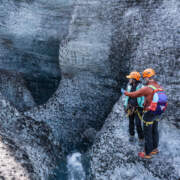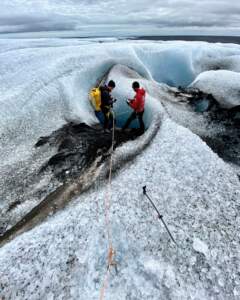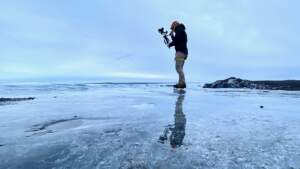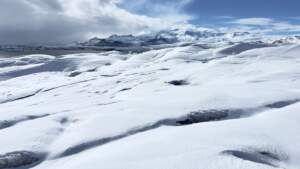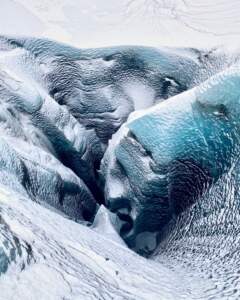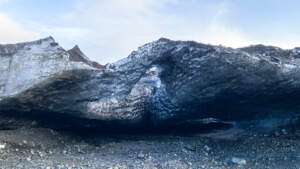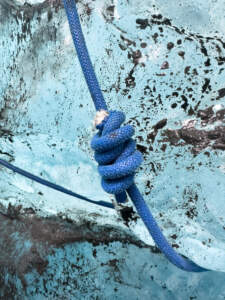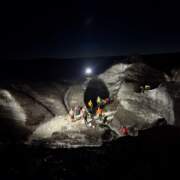The tragic collapse of an ice cave left us mourning the loss of a life, a family torn apart and many lives irrevocably changed. I have just returned from two days on the site of the incident, and staring at the computer screen I keep asking myself the same question again and again: How on earth could this happen?
This post is my attempt at answering this question, because only if we fully understand what went wrong can we hope to prevent it from happening again in the future.
My knowledge of what exactly occurred and even which guides or companies are involved is incomplete, so we must satisfy ourselves with exploring all possible options, not all of which may actually apply – but we will see that there is somewhat of a golden thread through this discussion.
I am not even going to name the company involved, because this is a systemic problem that has pervaded the entire industry. The first symptoms have been showing up for years, and critical voices were constantly ignored. So while clearly one company took things too far, this does not absolve everybody else from also taking a very long, hard look at our own practices, and trying to see where we can do better.
The Guide
First of all, it must be abundantly clear that the final decision on safety aspects of any tour must always be made by the guide who is on site. They are the last defense against any other safety measures that failed or were overlooked.
This requires training, experience, and the right mindset. A young and inexperienced guide, possibly with minimal training, is much less likely to have the confidence to “disappoint” their customer by turning away from something that maybe their gut instinct tells them is not looking quite right… but yesterday everything also went well so why should something happen today?
There is a very good reason why any formal guide training is usually in stages, where guides become increasingly independent – going from trainee (guiding under direct supervision by a more experienced guide), to apprentice (guiding under indirect supervision), and then finally to full guide (where they have accumulated enough experience to be able to make the correct decisions 99% of the time, and know how to safeguard against not catching the remaining 1% before it is too late).
The tour itself may be very low key – after all, most glacier experiences are at a level that is entirely suitable for first-time visitors – and not require any particular skills from the clients on a day-to-day basis. In many ways it is reminiscent of the job that flight attendants have – if all goes well it looks like they are just there to serve in-flight refreshments, but they are exceptionally well trained to deal with a variety of emergency scenarios that are incredibly unlikely.
All of this also requires the right company culture, where this process is encouraged and supported, and guides know their superiors will have their backs — even when they turn back and need to refund large sums of money to disappointed customers.
The Guide Company / Tour Operator
The company operating the tour, as a whole, is perhaps the central figure in this picture. They construct the tours, determine group size, locations, time constraints, and all other aspects of the operation.
Importantly, they determine which qualifications the guides have they will send out on each tour, under which constraints those guides operate, and most importantly also establish a certain company culture. In some instances there may be a construct of subcontractors, which is usually little more than false self-employment, and I think we can safely ignore this fact and just consider those as a single organization.
A guide that is sent out with minimal qualification and training, as pointed out above, will not have the necessary tools to make good and safe decisions, and will need to rely on instructions from their superiors – who may not be on site, and may be using outdated information. One of the critical aspects of late summer is how rapidly glaciers change, especially in August and September when they have been baked by sunlight and warm temperatures, and infrequent reviews are entirely inadequate. It would have been the company’s responsibility to ensure safety checks are performed sufficiently often, which in this time of the year may indeed be every single day.
Even with proper training, a company that encourages a “laissez-faire” approach to safety may weaken the guide’s perception of risk to the point that their own threshold for what is acceptable changes as well (“all the other guides still go, so it must be okay and my own perception must be off“).
One illustrating detail in this particular case is that it turns out we were looking for two additional casualties that did not actually exist – the total number of participants on the tour had been miscounted. In any mass casualty event, tracking and accounting for every single person involved is one of the most critical aspects. It is therefore quite surprising that in the moment when two persons were not accounted for, the numbers were not immediately verified. One would think that this would have been easy enough through the online booking systems even the smallest companies use nowadays, where people are “checked in” as they arrive, or at least tracking credit card receipts if there was a suspicion people had “walked in” without prior arrangements). Obviously each guide must have known how many passengers they had in their vehicles, or the clients themselves could have been interviewed to find out the seating arrangements and deduce any missing individuals, but humans are notoriously unreliable and possibly disoriented in the aftermath of such events.
In any case, the fact that the reported and actual numbers neither matched nor were corrected quickly does lead one to believe that the processes for tracking and accounting for customers on these tours were inadequate, or not followed, which may be symptomatic of a rather lax company culture in general (and thus possibly also towards safety).
Furthermore, a guide who is under tremendous pressure from their superiors may feel obligated to proceed with a tour against their better judgment, for fear of losing their job or prestige within the company. This problem is of course even more amplified if the guides are young and/or inexperienced, which makes it even more difficult to push back against one’s superiors and cancel the tour anyway.
The Online Travel Agency (OTA)
Finally, we should not forget to consider why a guide company feels the need to compel their guides to run certain excursions. And in my opinion, online travel agencies / marketplaces play a substantial role here. They are often the customer facing entity, during the booking process, and for many clients indeed indistinguishable from the actual operators.
Almost all companies also operate their own direct booking websites, but it is safe to say that for most tour operators the vast majority of clients will come through the major OTAs (Arctic Adventures, Guide To Iceland, Tröll, Viator, etc.).
As such, the OTA can potentially create a tremendous amount of pressure, especially if they are effectively the sole source of customers for a given tour operator – and just like as a guide, saying no to one’s superiors is difficult for fear of being replaced by another, more willing guide, a tour operator that declines to offer a certain activity may end up being replaced by another supplier. This, coupled with the misguided assumption that if other tour operators are willing to arrange a certain activity, it must be possible to do it safely, spirals into a continued decline of boundaries and possibly safety standards.
It takes very strong leadership as a company to push back against this market pressure, but I would also fault the OTA for creating this demand in the first place. They, of course, may be willing to sell anything since for them any activity results in a neat commission and basically no operational risk, and if they can offer something that the other OTA’s don’t have (such as a summer ice cave tour), they will really want to have that cake. And therefore they will prod the tour operators towards extending their season further and further until it becomes year round.
At the same time, if the OTA would have done their due diligence and evaluated the possible risks involved with each of the activities they offer, they might have come to the conclusion that such a tour cannot be operated safely, and thus never include it in their program. As such, they too failed to defend and protect their customers against an activity that for many years was well known to be too dangerous to consider but crept into the common marketplace in very recent years.
The Customer
And where does this leave the customer?
It would be easy to say that each customer is ultimately also responsible for their own safety, and if they would do their due diligence they should be aware of the risks involved and consciously accept them when booking.
That, in my opinion, is mostly incorrect. Of course we all are in the end responsible for our own wellbeing, but especially when it comes to guided tours we book those precisely because we are venturing into an unknown environment, and trust a trained professional to make it a safe and enjoyable experience.
Very few clients of glacier hikes or ice cave tours have the necessary knowledge, training or experience to accurately evaluate what constitutes a safe or unsafe environment, and even less so from a brief description on a website in a country that they may have never visited before (and thus also cannot really judge for example how the local climate factors in).
A certain amount of perceived risk, even if it does not relate to any objective danger, may even a welcome part of the experience of being on an adventure. But it is of course unacceptable to expose customers, oneself, or third parties to any objective dangers, perceived or unseen by customers.
And thus, we have come full circle.
The guide failed their customers because they did not perceive, address, or avoid a severe overhead hazard they were exposing their clients to during the tour.
The tour operator failed their customers because they were willing to arrange an activity that carries a very high risk in a highly volatile environment, without giving their guide the necessary tools, training, and support to mitigate the risks involved.
The online travel agency failed their customers because they were willing to sell those tours, marketing them as an entirely safe adventure.
But wait, there is more. The National Park, as the overseeing agency of all commercial operations within its territory, failed its visitors because they did not sufficiently monitor the commercial activities, perceive the increasing risks associated with those activities, or take suitable action.
Any one of those could have avoided the tragedy with suitable actions. None did. Out of complacency, financial motivation, external pressure, or ignorance.
What now?
How can we ensure this never happens again?
Some may point to quality management programs like VAKINN, but I very much doubt that is an actual solution. I have seen too many actions of guides from certified companies that are in clear violation of these standards. Paper, after all, is very patient.
Neither would a blanket ban on “summer ice cave tours” per se work. A sufficiently motivated company could easily just label them as glacier hikes of some sort where most of the time happens to be spent inside one of those structures. When ice climbing or visiting moulins, one could easily end up in a place that is quite similar in structure to the incident site but objectively safe and possibly the most memorable moment of the tour.
The only solution, in my opinion, is a thorough cultural shift that pervades all layers of the tourism industry.
We must put our customers’ safety at the front, throughout every decision we make. From OTAs ensuring customers come well informed about the right clothing and a good concept of what the tour might be like or how it might need to change, to tour operators and guides providing them with the right equipment and instructions. Guides having full authority over cancellations or changes as well as the training and experience they will need to make those decisions. Encouraging a company culture that prioritizes safety over all other aspects of the tour (including whether it takes place at all or not), having online travel agencies that decline to carry overly risky activities and explain to their potential customers why some tours may be seasonal, and having a National Park where the rangers have the training, authority, and legal framework to put a stop on commercial activities that are deemed unsafe. I could also envision an expert panel that reviews these activities, perhaps by anonymously booking them as seemingly regular guests.
Is all of this likely to happen? Probably not.
But one can dream, and one can set an example and hope others will follow.
Which is why write incident reports whenever I feel there is an important lesson to be learned. Why my safety plan is public, for everybody to read and hold me accountable for. Why I am organizing training days that are free of charge for other guides. And why in this text I am desperately grasping at ways to extract some sense of meaning from an event that should never have happened.
Because I want to live in a world where nature in all her beauty is enjoyable, exciting, an adventure — but first, and above all, safe.

